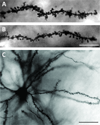Late-postnatal cannabinoid exposure persistently elevates dendritic spine densities in area X and HVC song regions of zebra finch telencephalon
- PMID: 21737064
- PMCID: PMC3428047
- DOI: 10.1016/j.brainres.2011.06.019
Late-postnatal cannabinoid exposure persistently elevates dendritic spine densities in area X and HVC song regions of zebra finch telencephalon
Abstract
Centrally acting cannabinoids are well known for their ability to impair functions associated with both learning and memory but appreciation of the physiological mechanisms underlying these actions, particularly those that persist, remains incomplete. Our earlier studies have shown that song stereotypy is persistently reduced in male zebra finches that have been developmentally exposed to cannabinoids. In the present work, we examined the extent to which changes in neuronal morphology (dendritic spine densities and soma size) within brain regions associated with zebra finch vocal learning are affected by late-postnatal cannabinoid agonist exposure. We found that daily treatment with the cannabinoid agonist WIN55212-2 (WIN, 1mg/kg IM) is associated with 27% and 31% elevations in dendritic spine densities in the song regions Area X and HVC, respectively. We also found an overall increase in cell diameter within HVC. Changes in dendritic spine densities were only produced following developmental exposure; treatments given to adults that had completed vocal learning were not effective. These findings have important implications for understanding how repeated cannabinoid exposure can produce significant, lasting alteration of brain morphology, which may contribute to altered development and behavior.
Copyright © 2011 Elsevier B.V. All rights reserved.
Figures





References
-
- Airey DC, Kroodsma DE, DeVoogd TJ. Differences in the complexity of song tutoring cause differences in the amount learned and in dendritic spine density in a songbird telencephalic song control nucleus. Neurobiol Learn Mem. 2000;73:274–281. - PubMed
-
- Bhatt DH, Zhang S, Gan WB. Dendritic spine dynamics. Annu Rev Physiol. 2009;71:261–282. - PubMed
-
- Bloodgood BL, Sabatini BL. Ca(2+) signaling in dendritic spines. Curr Opin Neurobiol. 2007;17:345–351. - PubMed
-
- Bottjer SW, Miesner EA, Arnold AP. Forebrain lesions disrupt development but not maintenance of song in passerine birds. Science. 1984;224:901–903. - PubMed
-
- Changeux JP, Dehaene S. Neuronal models of cognitive functions. Cognition. 1989;33:63–109. - PubMed
Publication types
MeSH terms
Substances
Grants and funding
LinkOut - more resources
Full Text Sources
Other Literature Sources
Molecular Biology Databases
Miscellaneous

